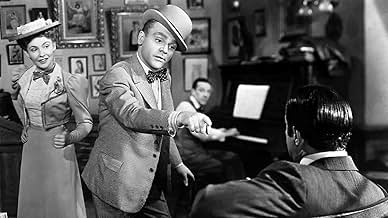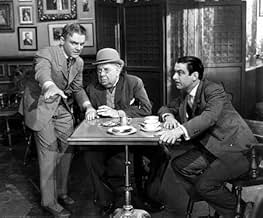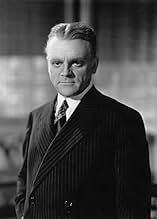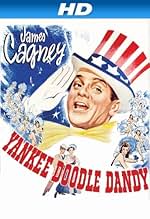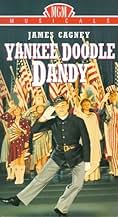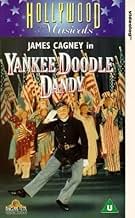AVALIAÇÃO DA IMDb
7,6/10
18 mil
SUA AVALIAÇÃO
A vida do renomado compositor musical, dramaturgo, ator, dançarino e cantor George M. Cohan.A vida do renomado compositor musical, dramaturgo, ator, dançarino e cantor George M. Cohan.A vida do renomado compositor musical, dramaturgo, ator, dançarino e cantor George M. Cohan.
- Direção
- Roteiristas
- Artistas
- Ganhou 3 Oscars
- 9 vitórias e 6 indicações no total
Patsy Parsons
- Josie Cohan - As a Girl of 12
- (as Patsy Lee Parsons)
Avaliações em destaque
10lugonian
YANKEE DOODLE DANDY (Warner Brothers, 1942), directed by Michael Curtiz, is an autobiographical musical of a legendary Broadway showman, composer, actor and dancer, George M. Cohan (1878-1942), as played by James Cagney in what's been reported as his personal favorite of all movie roles, and it's easy to see why. In spite the fact that Cagney won his only Academy Award as best actor, he was letter perfect in the role as Cohan. Interesting to see a noted movie tough guy singing and dancing, but it's even more-so in watching Walter Huston as Cohan's father doing a song and dance himself.
The story opens with the middle-aged Cohan (James Cagney), following a comical musical performance in "I'd Rather Be Right" in which he plays and spoofs the president (Franklin D. Roosevelt). He gets a telegram from the president himself to meet with him at the White House. Believing the worst, he arrives to meet "with the head man." Alone with him in the Oval Office, the two men converse which leads to Cohan to soon be relating his life story via flashback starting with his birth (born on the 4th of July), as the son of stage entertainers, Jerry and Nellie Cohan (Walter Huston and Rosemary DeCamp), followed by his boyhood days as the star of "Peck's Bad Boy" (Douglas Croft playing George at age 12), the teaming up with his younger sister, Josie (first played by JoAnn Marlowe, then by Patsy Lee Parsons, and by Jeanne Cagney as an adult) and his parents, forming the act called "The Four Cohans," George leaving the family to form an act on his own, his association with a young hopeful named Mary (Joan Leslie), whom he eventually marries, the publication of his songs that make him world famous, the death of his parents, his retirement from the stage and his return to Broadway to appear in a play that has summoned him with an invitation from the president, and after nearly two hours of recollection, the story moves forward to present day with Cohan to find out why he was really asked to come to visit with the president.
With a handful of song and dance tunes, many composed by Cohan himself, the soundtrack is as follows: "The Dancing Master," "The Dancing Master" (reprise); "Strolling Through the Park One Day" (by Joe Goodwin and Gus Edwards); "Minstrel Number," "I Was Born in Virginia," "The Warmest Baby in the Bunch," "Harrigan," "Yankee Doodle Dandy," "Yankee Doodle Dandy," "All Aboard for Old Broadway" (by Jack Scholl and M.K. Jerome), "Give My Regards to Broadway," "Oh, You Wonderful Girl," "Blue Skies, Grey Skies," "The Barber's Ball," "Mary," "Forty-Five Minutes From Broadway," "Mary" (reprise); "Forty-Five Minutes From Broadway," "So Long, Mary," "You're a Grand Old Flag," "Battle Hymn of the Republic" (by William Steffe and Julia Ward Howe); "When Johnny Comes Marching Home," "Of Thee I Sing," "You're a Grand Old Flag," "Come Along With Me," "Over There," "I'm Happy As Can Be," "Love Nest" (by Louis A. Hirsch and Otto Harbach); "Little Nellie Kelly," "The Man Who Owns Broadway," "Molly Malone," "Billie," "Jeepers Creepers" (by Johnny Mercer and Harry Warren); "Off the Record" and "Over There." Of the songs listed above, several could have been chosen as alternate titles in regards to Cohan, including: "Give My Regards to Broadway," "Grand Old Flag," "The Man Who Owns Broadway," or "Off the Record," but the final selection became "Yankee Doodle Dandy." While many of these songs are Broadway show tunes, the most memorable ones happen to be the patriotic songs, especially "Grand Old Flag," "Over There," and of course, the title tune.
In the supporting cast are Irene Manning (Fay Templeton); Richard Wholf (Samuel H. Harris); George Tobias (Mr. Dietz); George Barbier (Claude Erlanger); S.Z. Sakall (Mr. Schwab); Eddie Foy Jr. (Eddie Foy); Minor Watson (Edward Albee); and Frances Langford credited as a singer, but actually Nora Bayes. Listed bottom in the cast is Captain Jack Young as The President, who, during the opening and closing segments, is only visible by a back-view depiction.
YANKEE DOODLE DANDY started a new trend of bio-musicals that would become fashionable throughout the 1940s. As a movie, YANKEE DOODLE DANDY is a grand old musical that blends nostalgia of the past (early twentieth century, World War I) with patriotism of the 1940s. While very little is known of the real George M. Cohan today, the inaccuracies wouldn't really matter nor noticed. Cohan was actually married twice, but never to a girl named Mary. The screenplay, overall, fails to mention Cohan actually appeared in some motion pictures, one being THE PHANTOM PRESIDENT (Paramount, 1932) opposite Claudette Colbert. To watch that Cohan film is to see how close Cagney worked to impersonate him on screen. YANKEE DOODLE DANDY is true indication of Cagney not just as a movie tough guy, but his diversatility as an actor. Although the patriotism plays towards the World War II audience, much of Cohan's spirit of being an American continues to reflect upon the present generation.
Full of memorable lines, YANKEE DOODLE DANDY's most noted happens to be Cohan's closing speech following a performance, "My father thanks you, my mother thanks you, my sister thanks you, and I THANK YOU." Filmed with crisp black and white photography, YANKEE DOODLE DANDY did go through the process of colorization in the mid 1980s. While original Technicolor photography might have been its major asset, YANKEE DOODLE DANDY still ranks first rate entertainment for all ages, and one responsible in keeping the George M. Cohan name more alive today than ever before. Available on video cassette, DVD and through presentations on Turner Classic Movies. (**** flags)
The story opens with the middle-aged Cohan (James Cagney), following a comical musical performance in "I'd Rather Be Right" in which he plays and spoofs the president (Franklin D. Roosevelt). He gets a telegram from the president himself to meet with him at the White House. Believing the worst, he arrives to meet "with the head man." Alone with him in the Oval Office, the two men converse which leads to Cohan to soon be relating his life story via flashback starting with his birth (born on the 4th of July), as the son of stage entertainers, Jerry and Nellie Cohan (Walter Huston and Rosemary DeCamp), followed by his boyhood days as the star of "Peck's Bad Boy" (Douglas Croft playing George at age 12), the teaming up with his younger sister, Josie (first played by JoAnn Marlowe, then by Patsy Lee Parsons, and by Jeanne Cagney as an adult) and his parents, forming the act called "The Four Cohans," George leaving the family to form an act on his own, his association with a young hopeful named Mary (Joan Leslie), whom he eventually marries, the publication of his songs that make him world famous, the death of his parents, his retirement from the stage and his return to Broadway to appear in a play that has summoned him with an invitation from the president, and after nearly two hours of recollection, the story moves forward to present day with Cohan to find out why he was really asked to come to visit with the president.
With a handful of song and dance tunes, many composed by Cohan himself, the soundtrack is as follows: "The Dancing Master," "The Dancing Master" (reprise); "Strolling Through the Park One Day" (by Joe Goodwin and Gus Edwards); "Minstrel Number," "I Was Born in Virginia," "The Warmest Baby in the Bunch," "Harrigan," "Yankee Doodle Dandy," "Yankee Doodle Dandy," "All Aboard for Old Broadway" (by Jack Scholl and M.K. Jerome), "Give My Regards to Broadway," "Oh, You Wonderful Girl," "Blue Skies, Grey Skies," "The Barber's Ball," "Mary," "Forty-Five Minutes From Broadway," "Mary" (reprise); "Forty-Five Minutes From Broadway," "So Long, Mary," "You're a Grand Old Flag," "Battle Hymn of the Republic" (by William Steffe and Julia Ward Howe); "When Johnny Comes Marching Home," "Of Thee I Sing," "You're a Grand Old Flag," "Come Along With Me," "Over There," "I'm Happy As Can Be," "Love Nest" (by Louis A. Hirsch and Otto Harbach); "Little Nellie Kelly," "The Man Who Owns Broadway," "Molly Malone," "Billie," "Jeepers Creepers" (by Johnny Mercer and Harry Warren); "Off the Record" and "Over There." Of the songs listed above, several could have been chosen as alternate titles in regards to Cohan, including: "Give My Regards to Broadway," "Grand Old Flag," "The Man Who Owns Broadway," or "Off the Record," but the final selection became "Yankee Doodle Dandy." While many of these songs are Broadway show tunes, the most memorable ones happen to be the patriotic songs, especially "Grand Old Flag," "Over There," and of course, the title tune.
In the supporting cast are Irene Manning (Fay Templeton); Richard Wholf (Samuel H. Harris); George Tobias (Mr. Dietz); George Barbier (Claude Erlanger); S.Z. Sakall (Mr. Schwab); Eddie Foy Jr. (Eddie Foy); Minor Watson (Edward Albee); and Frances Langford credited as a singer, but actually Nora Bayes. Listed bottom in the cast is Captain Jack Young as The President, who, during the opening and closing segments, is only visible by a back-view depiction.
YANKEE DOODLE DANDY started a new trend of bio-musicals that would become fashionable throughout the 1940s. As a movie, YANKEE DOODLE DANDY is a grand old musical that blends nostalgia of the past (early twentieth century, World War I) with patriotism of the 1940s. While very little is known of the real George M. Cohan today, the inaccuracies wouldn't really matter nor noticed. Cohan was actually married twice, but never to a girl named Mary. The screenplay, overall, fails to mention Cohan actually appeared in some motion pictures, one being THE PHANTOM PRESIDENT (Paramount, 1932) opposite Claudette Colbert. To watch that Cohan film is to see how close Cagney worked to impersonate him on screen. YANKEE DOODLE DANDY is true indication of Cagney not just as a movie tough guy, but his diversatility as an actor. Although the patriotism plays towards the World War II audience, much of Cohan's spirit of being an American continues to reflect upon the present generation.
Full of memorable lines, YANKEE DOODLE DANDY's most noted happens to be Cohan's closing speech following a performance, "My father thanks you, my mother thanks you, my sister thanks you, and I THANK YOU." Filmed with crisp black and white photography, YANKEE DOODLE DANDY did go through the process of colorization in the mid 1980s. While original Technicolor photography might have been its major asset, YANKEE DOODLE DANDY still ranks first rate entertainment for all ages, and one responsible in keeping the George M. Cohan name more alive today than ever before. Available on video cassette, DVD and through presentations on Turner Classic Movies. (**** flags)
`Yankee Doodle Dandy' makes the viewer say, `They don't make them like that anymore.' The film is uplifting for its espousal of unabashed patriotism and its representation of America as a place in which a gifted performer like George M. Cohan could rise from vaudeville to Broadway. It is also moving for its reverence for the nineteenth late century theatre and early twentieth century Broadway: the sequence showing Cohan's successes of the 1920s commemorate the other musical and non musical hits of the decade as much as Cohan's. I was moved to tears by the ending showing the elderly Cohan joining in a World War II parade, a group of soldiers marching to `Over There' and being asked why he isn't singing, `Hey old-timer, don't you know this song?' `Yankee Doodle Dandy' is a celebration of Cohan's life and career -- a little sanitised perhaps, but still portraying his love for his family, his profession and his country. It isn't a museum piece but more of a picture from another era and in a time when America is honoured by songs such as `Kick Ass USA' it's a valuable reminder of an age when people feeling their country under threat roused their nationalism by reminding themselves of what made them want to fight for it.
Right from the start, I have to say you do not need to be an American to be caught up in the excitement of the blatant flag waving tribute to a great artist. "Yankee Doodle Dandy" made to boost morale after the U.S. entered the war surely would have achieved its goal. It would have been even better in Technicolor (not the coloured version later shown). The songs were great, the acting and the individual dancing style of James Cagney was superb and deserved the Oscar. The two scenes featuring "Over There" were very moving with Frances Langford a standout! The story, while bearing small resemblance to real life, was good and Walter Huston and Rosemary de Camp were excellent. When you see a film such as this some 60 years after its release, and still really enjoy it, it shows how the Golden Years of Hollywood were just that.
There are many, many James Cagney films that show his enormous talent as an actor. He was equally at home in musicals, dramas and comedies. While I have always been a fan and appreciate his unusual scope, this movie in particular caught my eye and totally blew me away when the scene I'm about to describe unfolded.
Near the very end of the film Cagney's character (George M. Cohan) bids farewell to the President and leaves the room. There is a long, open staircase he starts walking down. As he walks you sense a bit of a bounce beginning to take over his step.....one that quickly gives way to an awesome dance as he navigates the stairway. Many will not note, but this dance was a fantastic achievement on two fronts. One, it was done in one "take"...that is, the camera never stopped; the scene never "cut." The camera stays with him in one shot all the way through. Second, Mr. Cagney never ONCE looks at his feet or down at the steps. It's almost impossible to WALK down a staircase without looking down or hanging on to a banister....this man DANCED down a staircase without benefit of seeing or touching anything.
Couple this feat with the brilliant display of "hoofing" he gives earlier in the film when he literally dances up the walls and you have a movie that deserves its "classic" rating. If you haven't seen it please make it a point to do so. Any movie that is awe inspiring 62 years later must be worth a peek, don't you agree?
Near the very end of the film Cagney's character (George M. Cohan) bids farewell to the President and leaves the room. There is a long, open staircase he starts walking down. As he walks you sense a bit of a bounce beginning to take over his step.....one that quickly gives way to an awesome dance as he navigates the stairway. Many will not note, but this dance was a fantastic achievement on two fronts. One, it was done in one "take"...that is, the camera never stopped; the scene never "cut." The camera stays with him in one shot all the way through. Second, Mr. Cagney never ONCE looks at his feet or down at the steps. It's almost impossible to WALK down a staircase without looking down or hanging on to a banister....this man DANCED down a staircase without benefit of seeing or touching anything.
Couple this feat with the brilliant display of "hoofing" he gives earlier in the film when he literally dances up the walls and you have a movie that deserves its "classic" rating. If you haven't seen it please make it a point to do so. Any movie that is awe inspiring 62 years later must be worth a peek, don't you agree?
So it takes liberties with facts. So it's jingoistic. Big deal! I adore it for its depiction of turn-of-the-(20th}century New York, especially its theater, which has fascinated me for years. And it has the breath-taking performance of Jimmy Cagney in the title role; he's absolutely elecrifying in the musical numbers. If some scenes are mawkish, well, I think that can be forgiven.
This movie, above all others, make me so proud to be an American.
This movie, above all others, make me so proud to be an American.
Você sabia?
- CuriosidadesMany facts were changed or ignored to add to the feel of the movie. For example, the real George M. Cohan was married twice, and although his second wife's middle name was Mary, she went by her first name, Agnes. In fact, the movie deviated from the truth to such a degree that Cohan's daughter Georgette commented, "That's the kind of life Daddy would have liked to have lived."
- Erros de gravaçãoThe "You're A Grand Old Flag" number, supposedly takes place in the 1906 production of "George Washington Jr.," and uses multiple period flags to represent times before 1906. The Civil War flag, as an example, is correct for the time in question. However, in the final sequence characters carry, and an soft screen projection is made of, multiple 48 star flags. The 48 star flag was not introduced until 1912. In 1906, it should have been a 45 star flag. (Oklahoma was admitted to the Union in 1907, New Mexico and Arizona in 1912).
- Citações
George M. Cohan: My mother thanks you, my father thanks you, my sister thanks you, and I thank you.
- Versões alternativasAlso available in a computer colorized version.
- ConexõesFeatured in The Voice That Thrilled the World (1943)
- Trilhas sonorasThe Yankee Doodle Boy
(1904) (uncredited)
from the Broadway Show "Little Johnny Jones"
Written by George M. Cohan
Played during the opening credits
Sung and Danced by James Cagney and Chorus
Principais escolhas
Faça login para avaliar e ver a lista de recomendações personalizadas
- How long is Yankee Doodle Dandy?Fornecido pela Alexa
Detalhes
- Data de lançamento
- País de origem
- Idioma
- Também conhecido como
- Canção da Vitória
- Locações de filme
- Empresa de produção
- Consulte mais créditos da empresa na IMDbPro
Bilheteria
- Faturamento bruto nos EUA e Canadá
- US$ 11.800.000
- Tempo de duração
- 2 h 6 min(126 min)
- Cor
- Proporção
- 1.37 : 1
Contribua para esta página
Sugerir uma alteração ou adicionar conteúdo ausente



